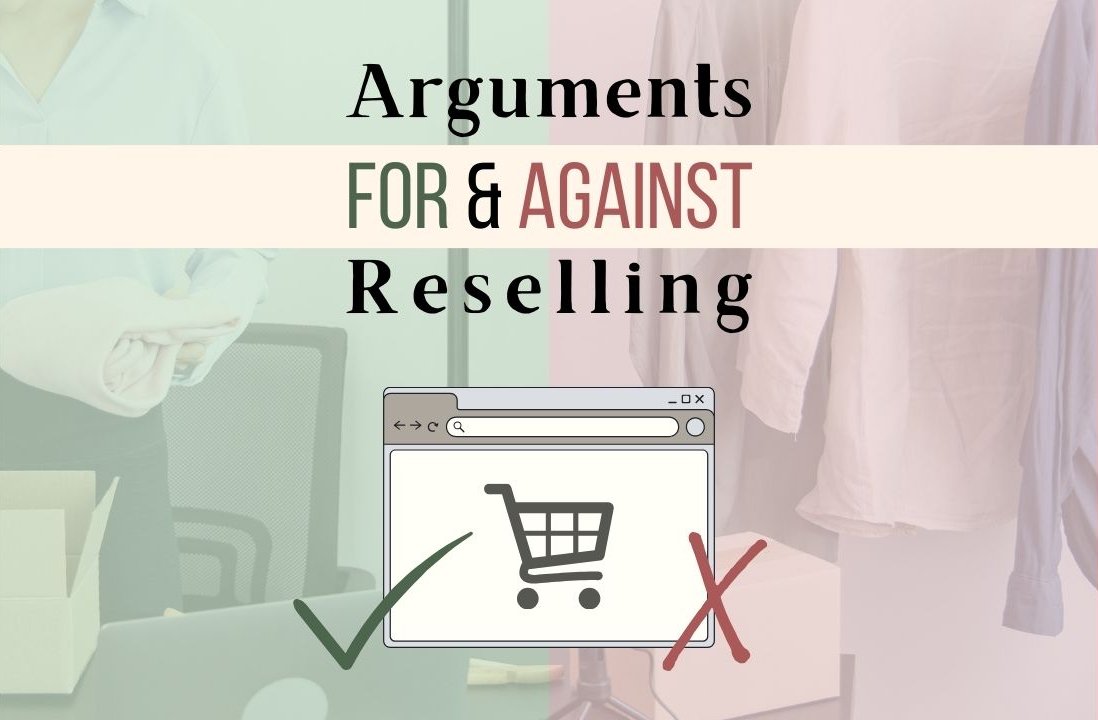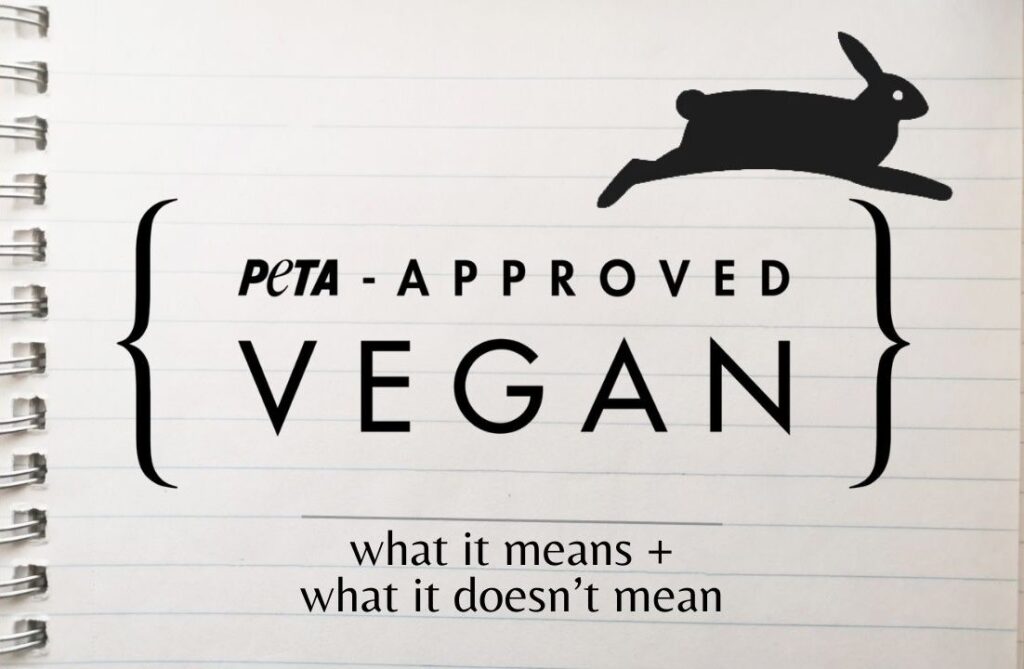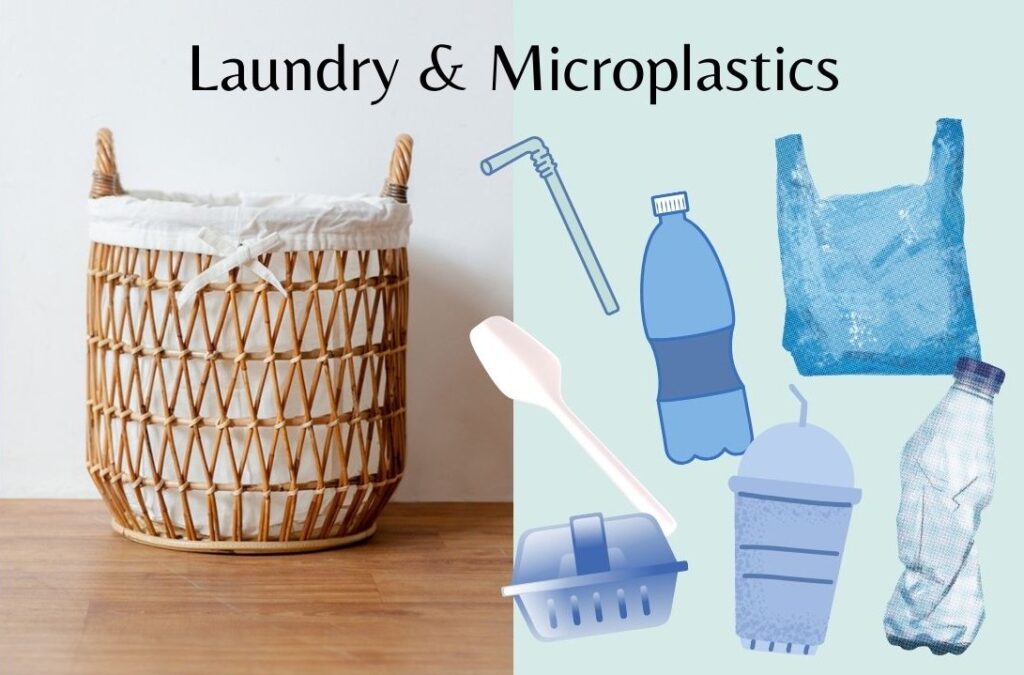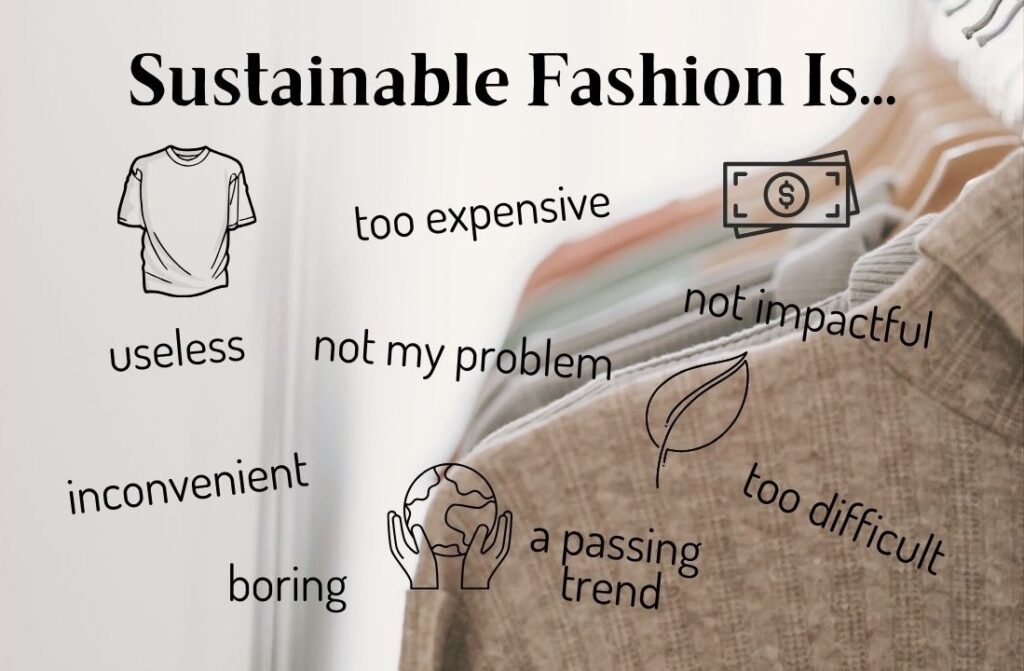Secondhand shopping is one of the most affordable ways to participate in sustainable fashion, but the landscape in this industry is changing. Thrifting has now become a trend and the practice of reselling pre-loved clothes has gained significant traction. Questions have arisen about the ethics of reselling, particularly when it comes to issues like pricing, accessibility and the environmental impact. It seems this debate has largely been polarised into two extremes. For this article, I researched both sides and gathered arguments for and against reselling secondhand clothes. I am hoping this overview will make it easier for you to form an opinion. At the end, I will also share my own thoughts and where I stand on this topic.
- What is a reseller?
- #1. Are resellers responsible for making secondhand fashion more expensive?
- #2. Are resale prices fair?
- #3. Are resellers taking away from low-income individuals who rely on secondhand products?
- #4. Are resellers making secondhand shopping more accessible or driving people away?
- #5. Is reselling good for the environment?
- #6. Are resellers taking all the nice and good-quality items from thrift stores?
- So what is my own stance?
What is a reseller?
First I want to clarify how I define resellers. I’m not talking about people who clean out their closet once in a while and sell their unwanted items. Finding a new home for your garments when you don’t want to wear them anymore is great, and we should all be doing that. This article is about individuals who buy pre-owned clothes they have no intention of wearing themselves. They buy them to resell in their own shop or on online resale platforms like Depop, Poshmark and Vinted. In order to make a profit, they charge more than what they originally paid themselves. For some, this is their full-time business, and others do it to supplement income.
Now let’s look at 6 common questions we can ask about reselling secondhand clothing. The arguments for both sides were gathered from several articles, forums and social media platforms.
#1. Are resellers responsible for making secondhand fashion more expensive?
In favour of reselling
Resellers are not responsible for products at thrift stores becoming more expensive. There are other reasons why the prices went up. Running a business has become more expensive with rising costs for rent, transportation, equipment, etc. Thrift stores choose higher prices for the most desirable items in order to cover the costs of running the store and to process the donations that don’t get sold. There is also more demand now for secondhand fashion and it’s natural for high-demand products to be more expensive. Some resellers even claim secondhand pricing has not changed at all, and others believe it has but that’s only because of corporate greed.
Not In favour of reselling
Resellers can cause rising prices at thrift stores in different ways. The resale market may make secondhand shops realise they are missing out on profit, so they start charging more for their products. With secondhand fashion being so visible nowadays and resellers heavily promoting it online, doing product and market research is easier than ever. This can also influence thrift stores to hold aside their best items for online auction instead of putting them on the sales floor. Small thrift shops might even raise their prices to prevent resellers from clearing out the shop and buying things in bulk.
#2. Are resale prices fair?
In favour of reselling
Resellers are justified in charging higher prices for different reasons:
- Consumers have an unrealistic view of value and price. If a secondhand product is clean and in good condition, it is still worth a lot and the price should be chosen accordingly.
- Resellers do a lot of work and have to cover expenses for sourcing, laundering, mending, measuring, photographing, listing, packaging and shipping. Not everyone has the skills and expertise to run a resale shop and they deserve to be compensated for that.
- Resellers do research on the products and find out how much they’re worth and how much their audience is willing to pay.
Not all resellers charge ridiculously high prices, and some consumers don’t even mind paying more. If resellers are honest about what it is and someone is willing to pay for it, they’re not doing anything wrong.
Not In favour of reselling
The price gouging and overpricing done by resellers can get out of hand and it’s not always fair. A lot of items are heavily overpriced. Low-quality fast fashion pieces are sold for more than the original price. Resellers might thrift something for 5 $/€/£ and post it online for 10 times more. A lot of these items are not actually worth that much.
It can also become an endless cycle where resellers buy from each other and increase the prices each time. This can create unhealthy competition. A nice reseller might make an effort to keep their prices reasonable and accessible, but then another reseller might see this and buy their things only to sell them for much higher prices. The resellers that just want to do something good could feel pressured to adjust their own pricing. Should we really encourage this cycle of profiting off of clothes as much as possible and seeing who can earn the most money from an item?
#3. Are resellers taking away from low-income individuals who rely on secondhand products?
In favour of reselling
Thrifting should be available for everyone, not just low-income people, and how do we define ‘low-income’ or ‘poor people’ anyway? Who is too wealthy for thrifted garments?
Not every reseller buys in bulk from thrift stores and goes shopping often. Some just get a couple of things every few weeks and make sure there are still things left for others to grab. Also, a lot of resellers only source certain brands. People who shop out of necessity might not care what brand they’re wearing, so it’s okay if they aren’t available at thrift stores as much.
Not all resellers are wealthy or even middle class themselves. Some are lower-class individuals who rely on reselling to earn enough income. Others may not have many other job options, because they are stay-at-home moms, or have a disability or health issues.
Not In favour of reselling
Secondhand shopping should be a source for low-income families to have access to nice and decent quality garments. Many thrift stores receive donations for free or a small fee, which allows them to provide budget-friendly fashion. Resellers are taking advantage of this system to earn money themselves.
If resellers take all the good-quality items and trendy brands from thrift stores, only leftover lower-quality and less desirable pieces will remain for the people who don’t have the option to shop elsewhere. Just because they have to thrift out of necessity, doesn’t mean they don’t deserve to also have access to nice things.
Whether resellers are middle or low class themselves is irrelevant. The point is that if an item from a thrift store gets posted online, it’s always going to be more expensive than it was originally. An item from the thrift store that was once affordable for someone, might now not be affordable anymore. Or they might have to reduce other expenses in their life in order to buy clothes.
#4. Are resellers making secondhand shopping more accessible or driving people away?
In favour of reselling
Reselling makes secondhand fashion more accessible for people who might otherwise not participate in it. Maybe they live in an area that doesn’t have many secondhand stores, or they may be looking for very specific items for their size or body type, or a certain brand. Designer items, for example, are easier to find in bigger cities. Resale increases demand for secondhand shopping and therefore discourages people from buying new products.
Some people also might not have time. Thrifting in-person sometimes takes longer if you have specific wishes, because you might have to visit a couple of places before finding something satisfactory. Resellers provide a service and take work off their customers’ hands, so they don’t have to spend their time and effort. This job is necessary and adds value.
Certain things are also easier to sell online instead of at a thrift store, for example adaptive clothes or shoes (designed for specific needs or disabilities). The chances are very slim that a person looking for those specific adaptive items would find them at that one store. Posting those items online increases the probability of finding a match.
Not In favour of reselling
Resellers make online secondhand shopping easier, but in-person harder. It is especially more challenging for those who rely on local thrift stores, because they notice there are less options now and they may not have the means to shop online.
Resellers definitely drive demand for secondhand shopping, but more demand also results in higher prices. This could steer consumers back to fast fashion, because they might find that it’s cheaper than secondhand. The reselling system could also encourage people to continuously buy a lot of items, wear them once and ship them to someone else again, which is still not an eco-friendly approach to fashion.
Many people have already been deterred from going to secondhand shops and resale platforms. Instead, they choose other avenues, such as clothing swaps. Some people don’t even want to donate to thrift stores anymore, because they are tired of seeing resellers profit off their items.
The service resellers provide is not always necessary. Some of the items they pick up from the thrift store don’t need help to be sold and would easily be bought by someone.
#5. Is reselling good for the environment?
In favour of reselling
Resellers encourage circularity which is beneficial for the environment. They ensure clothes are reused, kept out of landfills and the lifespan of the items is extended. This decreases the need for production of new garments and thus resources like energy and water are saved.
Thrift stores receive an insane amount of new stuff every day. The majority of the donations doesn’t end up getting sold there. All this unsold inventory is either resold to other stores, exported overseas, sent to landfills, downcycled into different products, or incinerated. Resellers are contributing to reducing all this textile waste.
Buying secondhand products in general is good for the environment and an ethical way of consuming, and the emissions from shipping are still nothing compared to the emissions from manufacturing new products.
Not In favour of reselling
Resale’s contribution to driving circularity might not be as big as it seems. If resellers only focus on taking high-demand and sellable items from secondhand shops, how much are they really saving from landfill? Many of those items would’ve most likely been bought by a local customer had they had the chance to see it before it got snatched up by a reseller.
Taking products home to resell doesn’t automatically mean they are saved from becoming waste. Resellers might also not be successful in selling every single item and may find themselves back at a thrift store to return things. Some might even throw clothes in the trash if they can’t be bothered. Just like at thrift stores, there could be a lot of waste in the resale community and we don’t know what all of them do with their own unsold inventory.
Just because secondhand shopping is inherently environmentally-friendly, doesn’t mean you can’t take it too far and create a harmful business. Online reselling creates unnecessary environmental impact from shipping. If you order a secondhand item from the other side of the world and ship it to another country again, you’re not doing the environment many favours. A lot of items could’ve been bought physically at a local thrift store, but now they’re being shipped all over the country or even world. Some people also dropship cheap new products and claim they’re pre-owned, or choose unsustainable new plastic bags as packaging.
#6. Are resellers taking all the nice and good-quality items from thrift stores?
In favour of reselling
There are other reasons why there aren’t many nice pre-owned items available. For example:
- Fast fashion is currently dominating the industry, so it makes sense these cheap, low-quality garments are also dominating thrift stores.
- More people, not just resellers, are participating in reselling. This means people sell their best items themselves online, and donate the lower-quality items to the thrift stores.
- Some thrift stores auction off their best items, so they’re not available in the store.
- If people know not everything gets sold at the thrift store, they may opt for rehoming their clothes in a different way instead of donating.
There are more than enough clothes available in the world and you can still find affordable and good-quality clothes at thrift stores if you spend enough time and effort to look for them. Not all resellers go there every day and only take the desirable things. There are also resellers who buy the stained and damaged items that are less sellable. They repair, clean and resell them.
Also, not every reseller sources from thrift stores. There are other ways to get inventory, for example directly from clothing companies (deadstock, damaged or unsold items), estate sales, yard sales, raghouses, auctions, or outlets from thrift stores (the items they never unloaded in their stores).
Not In favour of reselling
There are resellers or scalpers who frequently buy sought-after items in bulk to resell for a higher price. They show up at the stores as soon as they are restocked and clear out all the trendy branded items or for example, all the coats during winter.
Resellers generally look for good-quality fabrics, true vintage, and stylish and undamaged pieces. They leave the thin, synthetic fabrics, and worn-out and dirty items for others. The clothes that end up being wasted and are sent to landfill are oftentimes not items resellers are interested in anyway.
So what is my own stance?
Another common criticism I read from the non-supporters is that reselling is morally bankrupt. And I can kind of see where they are coming from. We can discuss numbers and statistics, but what about morality? Reselling is not a crime and everyone is free to take and resell what they want, but something that’s legal can still feel a little immoral and distasteful.
I once saw really unique vintage boots on the resale platform Vinted and had them saved in my favourites. They were quickly sold, but a few days later I saw those exact boots on the Instagram page of a thrift store near me. Those boots could’ve easily been sold directly to a happy buyer who would actually wear them. I read other similar experiences online where people saw resellers empty entire boxes or racks of one type of item into their cart at the thrift store and posted them all on resale platforms. While they’re not technically doing anything wrong, it still feels a little inconsiderate. And in this case it’s also not beneficial for the environment.
Many resellers like to hide behind the ‘it’s good for the environment’ argument, but that’s not always true. You can essentially say greenwashing also exists in the resale market. Thrifting has become a huge trend in the past few years, and when something sustainable becomes trendy, it’s pretty much a guarantee that it’s also going to reach people who don’t care about the environment and ethics. Some resellers only do it for their own financial gain and behave terribly by lying and misrepresenting their products.
And yes, there are bad apples in any industry, which brings me to the conclusion I have come to after researching both sides: neither side is right or wrong. It’s not black and white. I noticed a lot of people use language like: ‘resellers are this’ or ‘resellers do that’. The truth is, we can’t group all resellers together. There are sustainable and unsustainable clothing brands, and the same is true about resellers.
The way we’re able to separate the sustainable brands from the harmful ones is by demanding transparency from them about their business practices. Have we come to the point where we should start treating resellers the same and also demand honesty about the origins of their items?
I think the biggest takeaway is that you just have to be sensible with it if you want to resell. We shouldn’t lose sight of what makes secondhand shopping so sustainable, which is that it prolongs the lifespan of clothes and keeps them out of landfill. If you don’t contribute to this with the things you’re reselling, then you can’t claim you’re running a sustainable business.
How to resell Ethically
I think there is definitely a place for resellers in the sustainable fashion industry, and they could do some great things for the world if they have good intentions. Here’s a quick summary of how reselling can be done sustainably:
- It’s great if you take torn or worn-out items and mend and clean them to resell, because those items are not likely to be bought. If you go to a thrift store as soon as new inventory arrives and take out all the nice good-quality items, you didn’t even give the local community the chance to have a look.
- You can really help the environment if you focus on items that are difficult to sell and leave the items that are the most wanted.
- Sourcing and reselling in-person is better than online, because then you can avoid shipping emissions.
- In the same vein as the previous one: shipping to local customers in your own country or continent is much more eco-conscious than accepting orders from all over the world.
- Avoiding thrift stores and sourcing inventory elsewhere is generally more helpful.
- Charging reasonable and fair prices helps keep secondhand fashion accessible for everyone, and ensure people don’t go back to the cheaper option of fast fashion.
- Overconsumption is still bad if you do it with secondhand products. It’s all about moderation and being mindful of what you take and leave.
- Buying a highly desirable product from another reseller only to resell it yourself has no benefit for the environment at all. If anything, it has a negative effect, because you unnecessarily shipped a product.
- Making reselling your only source of income is risky. If you rely on reselling to pay your bills, you’ll feel more pressure to sell as much as possible and for as high of a price as possible.
- Greenwashing can very much be a thing in resale as well. An example of this is buying new fast fashion items and claiming they are pre-loved and from a different brand.
- Resellers can also create a lot of waste themselves if they’re unable to sell everything. It’s important to deal with leftover items in a sustainable way.
Would love to hear all your thoughts on this! Did I leave anything out or is this a pretty accurate outline of the reselling debate?
Also, check out this article where I debunk 5 common misconceptions about sustainable fashion!

